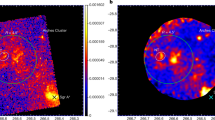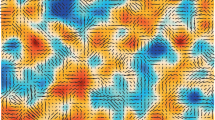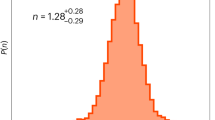Abstract
MEASUREMENTS of the linear polarization of quasars at a wavelength of 49 cm (m49) have already shown that this parameter is correlated with spectral index α (ref. 1). We have now observed a more complete sample of 93 quasars, all of which have measured redshifts. The correlation between m49 and α is confirmed, but a further correlation has been detected, namely between m49 and redshift z. The relation between m49 and z is shown in Fig. 1. The redshifts are taken from Burbidge and Burbidge2, Schmidt3 and Hiltner et al.4. The spectral indices represent the spectral slope at or near 49 cm. The separation between flat spectrum and steep spectrum quasars is especially marked for low redshifts (z < 1.25). This separation does not exist for polarization measured at shorter wavelengths, and is therefore a depolarization effect, presumably by Faraday rotation within the source. Fig. 1 shows that the median value of m49 falls markedly as z increases for flat spectrum quasars. The median value of m49 is almost independent of z for steep spectrum quasars.
This is a preview of subscription content, access via your institution
Access options
Subscribe to this journal
Receive 51 print issues and online access
$199.00 per year
only $3.90 per issue
Buy this article
- Purchase on Springer Link
- Instant access to full article PDF
Prices may be subject to local taxes which are calculated during checkout
Similar content being viewed by others
References
Gilbert, J. A., Conway, R. G., and Kronberg, P. P., Nature, 223, 1252 (1969).
Burbidge, G. R., and Burbidge, E. M., Nature, 222, 735 (1969).
Schmidt, M., Astrophys. J., 151, 393 (1968).
Hiltner, W. A., Cowley, A. P., and Schild, R. E., Pub. Astron. Soc. Pacific, 78, 464 (1966).
Berge, G. L., and Seielstad, G. A., Astrophys. J., 148, 367 (1967).
Gardner, F. F., Morris, D., and Whiteoak, J. B., Austral. J. Phys., 22, 77 (1969).
Bologna, J. M., McClain, E. F., and Sloanaker, R. M., Astrophys. J., 156, 815 (1969).
Sastry, Ch. V., Pauliny-Toth, I. I. K., and Kellermann, K. I., Astron. J., 72, 230 (1967).
Gardner, F. F., Whiteoak, J. B., and Morris, D., Austral. J. Phys., 22, 821 (1969).
Wagoner, R. V., Astrophys. J., 149, 465 (1967).
Bahcall, J. N., and Spitzer, L., Astrophys. J. Lett., 156, L63 (1969).
Author information
Authors and Affiliations
Rights and permissions
About this article
Cite this article
CONWAY, R., GILBERT, J. Linear Polarization of Distant Quasars. Nature 226, 332–333 (1970). https://doi.org/10.1038/226332a0
Received:
Issue Date:
DOI: https://doi.org/10.1038/226332a0
This article is cited by
-
Radio polarisation of quasars with optical absorption spectra
Nature (1977)
-
Radio Source Depolarization, Size and Cosmology
Nature Physical Science (1973)
-
Quasar Absorption Lines and Radio Polarization
Nature (1970)
Comments
By submitting a comment you agree to abide by our Terms and Community Guidelines. If you find something abusive or that does not comply with our terms or guidelines please flag it as inappropriate.



